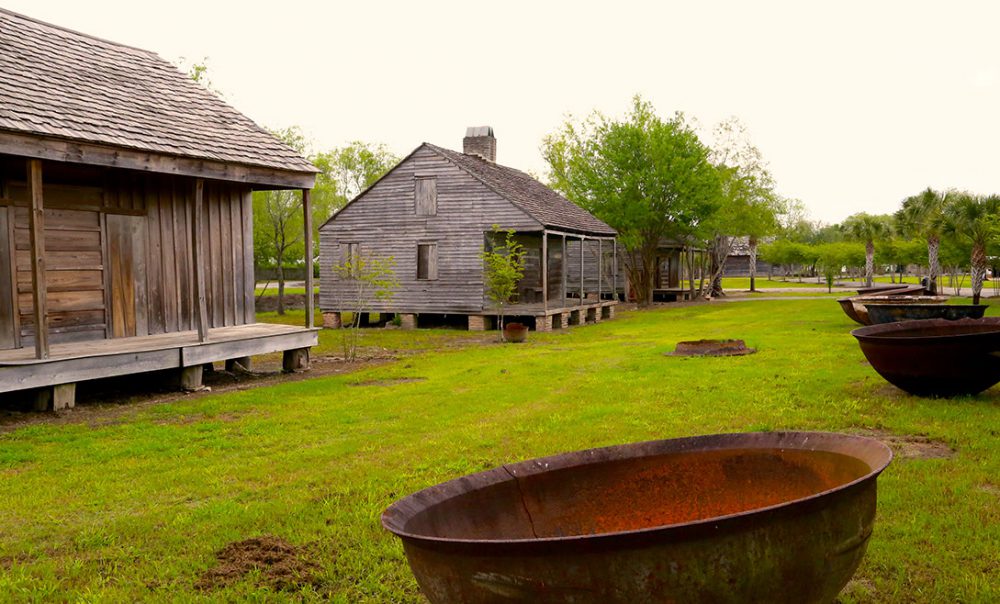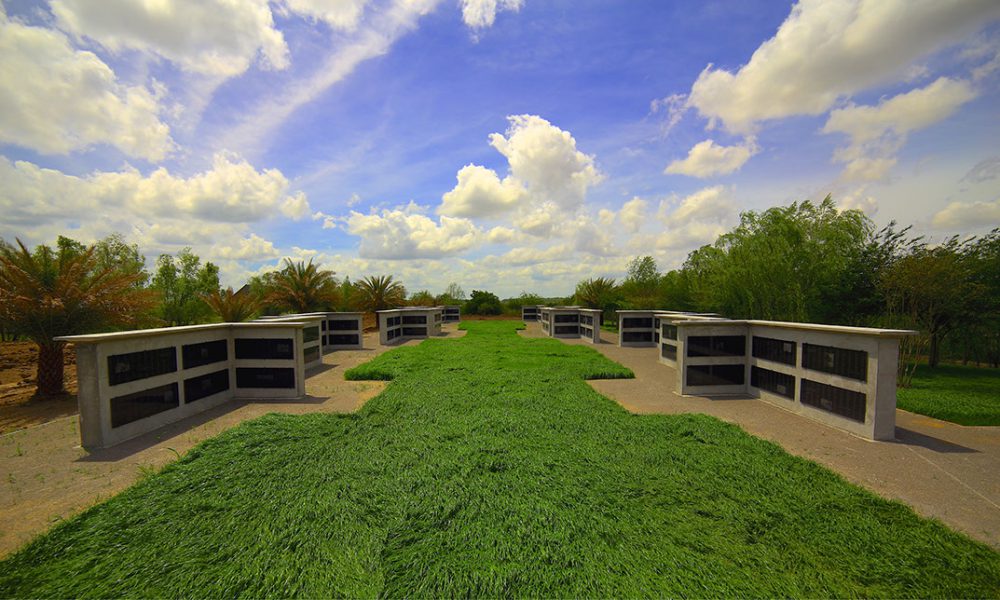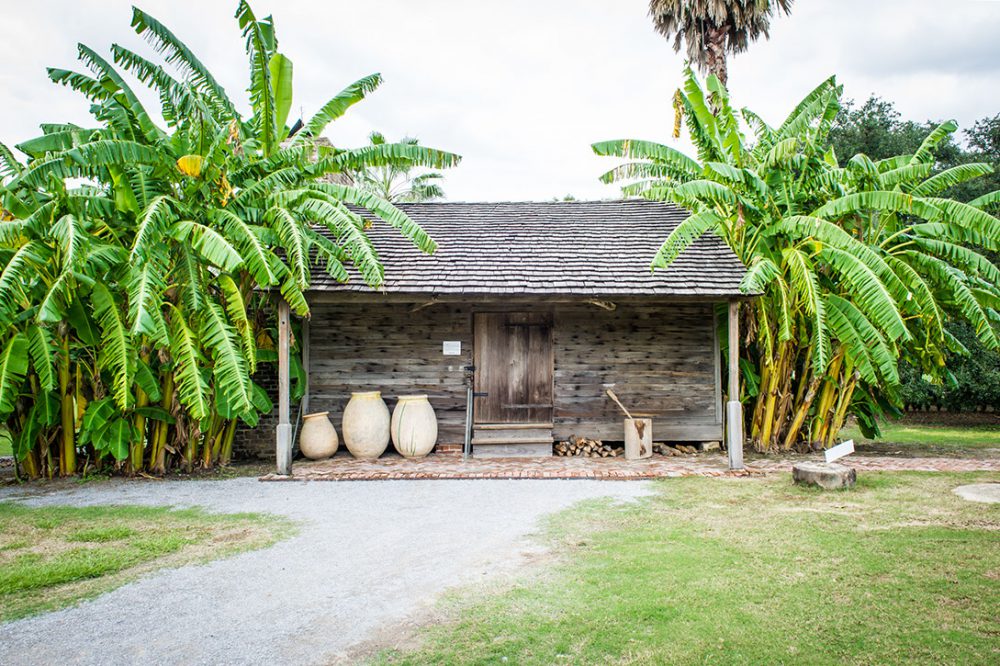Memorializing Slavery on Louisiana’s River Road: The Whitney Plantation
Sarah Dupee takes a drive to the Whitney Plantation, which aims to offer a more comprehensive narrative of the legacy of slavery in the American South.

Preserved cabins and sugar kettles on the grounds of the Whitney Plantation. Courtesy the Whitney Plantation, Wallace, Louisiana.
Such curious kinks of the human mind exist and must be reckoned with soberly. They cannot be laughed away, nor always successfully stormed at, nor easily abolished by act of legislature. And yet they must not be encouraged by being let alone. They must be recognized as fact, but unpleasant facts; things that stand in the way of civilization and religion and common decency.
W.E.B. Du Bois, The Souls of Black Folk
Within about an hour’s drive of New Orleans, along Louisiana’s historic River Road, there are over half a dozen former sugarcane plantations offering historic tours to the public. Each plantation has its own unique story to tell, based on the families who lived there and the spaces they occupied along the Lower Mississippi River. Tying them all together is a dominant narrative centered on the Big House, where affluent European planters sought to establish a dignified, Old World lifestyle on a New World frontier. The resulting gems of Creole and Anglo architecture and landscaping, carefully restored to their former glory, constitute the bulk of Louisiana’s River Road tourist industry.
Notoriously missing from these narratives, however, is the perspective of the enslaved. Such plantation tours will often pay lip service to slavery—“this house was built by slave labor”—before moving seamlessly on to describing the artifacts that served to make life as comfortable and enjoyable as possible for plantation masters. Most River Road sites have restored slave cabins on their grounds, but they exist only as an afterthought. A guided tour at Oak Alley Plantation, for example, emphasizes a Gone With the Wind aesthetic, which prevails in the elegant, white-columned Greek Revival mansion, grand live-oak allée, and elaborate, decorative gardens. Very little is said of the slaves’ lives, the contributions of their African heritage to local and regional culture, or the legacy of their oppression. In an attempt to fill this gap, Oak Alley has added, in the past few years, a permanent exhibit about its “enslaved community,” as well as an online slavery database. This recent amendment is in step with what seems to be a growing push, also seen at other sites, to round out the plantation story.
It is in this context that the Whitney Plantation arrived on the scene. The Whitney opened to the public in 2014, establishing itself as River Road’s newest historic attraction and one determined to offer a very different interpretation of plantation life, with the history of slavery treated not just as an afterthought, but as the site’s raison d’être.

The Allées Gwendolyn Midlo Hall are dedicated to the 107,000 people who were enslaved in Louisiana and were documented in the namesake professor’s database Afro-Louisiana History and Geneology, 1719-1820. Courtesy the Whitney Plantation, Wallace, Louisiana.
The Whitney indeed succeeds in taking the dominant plantation narrative—the one that starts and ends with the Big House—and flipping it on its head. Guests are guided through the grounds where enslaved people lived and worked, with memorials, statues, and monuments to former slaves throughout. It treats the Big House only as secondary and forces visitors to reckon with a side of a plantation that is more like a sun-beaten desert or an unruly, watery wilderness, far from the cool shade of live oaks, covered verandas, and sumptuous gardens. “If I start running, you start running,” our tour guide warned us. “We are in a swamp, after all.”
Guests are led from the gift shop to a small white chapel—a church of former slaves—to find a seat in the wooden pews facing the altar. The tour thus begins in a space of contemplation and reverence, setting a tone that at once seeks to ennoble and confront. The guide introduces herself with a sober disclaimer—her goal is not to elicit shame or anger, but to simply tell a story that must be allowed to speak for itself. A short video presentation outlines the history of the Whitney, which began as an indigo plantation called Habitation Haydel, established by German planters in the mid-1700s. Attention then shifts definitively from planters to slaves.
Enslaved children, memorialized in clay statues by Ohio-based sculptor Woodrow Nash, stand erect among the pews. These figures serve as a central visual motif at the Whitney, representing the individuals who lived to tell the tale of plantation life from the perspective of the enslaved. In the 1930s and ’40s, the Federal Writers’ Project managed to locate and interview hundreds of remaining survivors of slavery in Louisiana. The resulting first-person narratives reflect on slavery in the survivors’ words and according to their memories. These recollections and anecdotes are used by the Whitney to breathe life into the plantation’s historic buildings, sculptures, and memorials.
One such memorial is the Field of Angels, where the names of 2200 Louisiana slave children are engraved on granite walls, along with quotes recounting details of everyday life on a plantation. The walls surround a bronze statue of a black angel cradling a baby. Each name listed represents a child who died before the age of three—either at the Whitney or another Louisiana plantation—as documented in the sacramental records of the Archdiocese of New Orleans.
Aside from rare oral-history projects like the Federal Writers’ Project, historic plantations must rely almost exclusively on property inventories, courthouse documents, and sacramental records to know anything about the enslaved. Given these primary sources, slaves are spoken of primarily in terms of their monetary and utilitarian value, with only the most basic biological details, such as name, age, skill-set, and possibly origin. They enter the plantation story as the estate’s most valuable asset and little else. The Whitney steps in to reinforce the dignity of its enslaved by digging deeper and pulling in oral histories that reveal many missing details of interior life, longing, struggle, and everyday human activities.
Visitors are led to consider what can result when a human being is put in the same category as livestock, tools, and furniture. It investigates the violences of a system that, in the words of W.E.B. Dubois, “classed the black man and the ox together.”

The kitchen at the Whitney Plantation. Courtesy the Whitney Plantation, Wallace, Louisiana.
The Whitney takes every opportunity to remind us that slaves were not just the hands that worked the fields, built the house, and serviced domestic life; they were individuals who had no rights or protections against inhumane conditions, harsh punishments, and every type of abuse and exploitation, including practices of human breeding. This is particularly apparent at the Wall of Honor, a memorial to all those were were enslaved on Whitney Plantation. Each person is listed by name and some biographical detail, with each “mulatto” designation implying the sexual exploitation of an enslaved woman by a white master. The tour lingers here, taking time to spell out what the lack of rights or protections could mean for an enslaved woman.
At the same time, the Whitney takes every opportunity to honor the human spirit’s capacity for resistance, resilience, resourcefulness, and creativity, even in the most oppressive circumstances. From its carefully curated bookshop to its commentary throughout the slave quarters, garden plots, and kitchen, the Whitney highlights the foodways, folktales, and musical forms of plantation slave communities. Many aspects of Southern culture and American identity can now be traced back to these plantations and, ultimately, to Sub-Saharan Africa. These influences help tell the story of people who resisted dehumanization and forged communities in exile.
This is an ambitious project of deconstructing and transforming mindsets, as related to American cultural production and history. Stories of the enslaved experience also uncover the more menacing connotations of otherwise seemingly positive or neutral objects and symbols. The fleur-de-lis—the common symbol of French, and consequently New Orleanian, heraldry—for example, was actually seared by hot iron into human flesh, enforcing ownership and domination. The sugar kettles and sugar “trains” scattered throughout the grounds are cast as sites of back-breaking labor and gruesome injury.
Even freedom itself—the moment of Emancipation—is recounted in terms of both jubilation and tragedy. A contemporary statue of a figure with hands stretched towards the sky memorializes the long-awaited joy. But this does not preclude suspicions, according to our guide, that Emancipation also had devastating consequences for slaves who were executed or possibly even buried alive, as some archeological evidence suggests. This is a sharp contrast to other plantations that mention Emancipation primarily from a labor management perspective—the transition from unpaid labor to paid labor—with demonstrated changes in inventory and the inauguration of a payroll system, so to speak.
The Whitney, however, seeks to deconstruct the notion of “paid laborers” altogether, insisting, with underlying rage, that American slavery has more in common with genocide than a system of involuntary servitude. A “slave” is not the same thing as a “laborer,” contrary to what other plantations might tell you, our tour guide stated indignantly. She drove the point home by explaining that Adolf Hitler himself looked to American slavery practices as a model.
The plantation narrative is thus reframed in such a way that visitors must grapple with the deep-seated trauma that must have arisen from generations of dehumanization and disenfranchisement. After centuries of viewing and treating an entire race as subhuman, the shift from slavery to freedom could only be an abrupt and violent break, having altered the psychology of everyone involved—oppressed and oppressor alike.
If the spirit of the Whitney verges on confrontational, it is perhaps because it not only tells a difficult story, but one that it believes has been covered up at other similar sites too often and for too long. If there is anger, it is for those individuals whose lives, bodies, souls, thoughts, aspirations, families, and stories did and do matter, in sacred ways, though many have failed to realize it.
The Whitney goes well beyond reinterpreting the history of a River Road plantation. It appears to assert itself, in a timely manner, as an uncomfortable corrective for a country whose dominant narratives tend toward only the best of its foundations, traditions, and status quo, at the expense of acknowledging and reconciling multiple, contradictory, and ugly truths.



